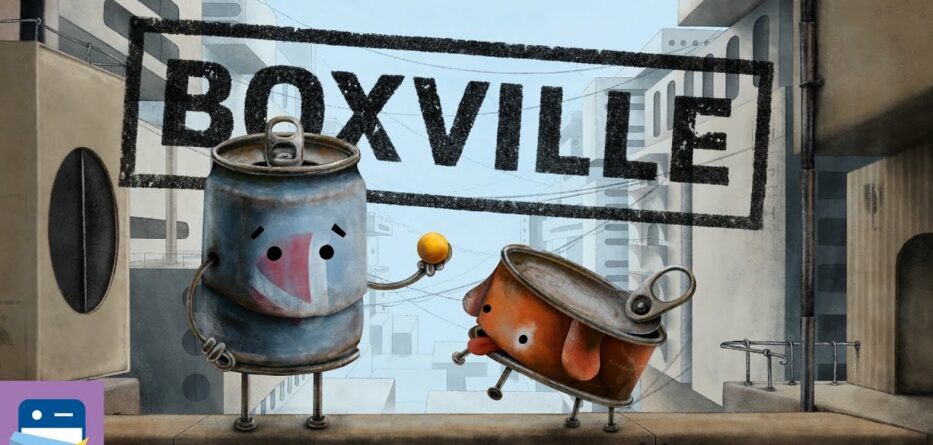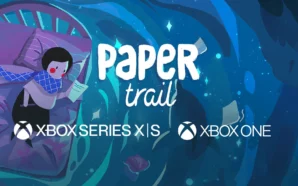Welcome to Boxville: the cardboard city inhabited by quaint tin cans. Earthquakes start to disrupt the city, and in the mayhem, Blue Can loses his pet tin dog. On a mission to rescue Rusty, Blue Can leaves the familiarity of home and has to confront the unsavoury side of Boxville.
Story
It’s a beautiful day, and Blue Can and Rusty are playing fetch on their rooftop garden when a sudden tremor sends them hurtling over the edge. Obsessed with his ball, Rusty continues to follow it, descending further down into the depths of Boxville. The earthquake has disrupted everyone else’s lives too; the gardener has lost her water supply, the janitor has lost his broom, and a sleepy old tin man’s sofa blocks Blue Can’s way. Before Blue Can can rescue Rusty, he is going to have to fix Boxville and put an end to those pesky earthquakes.
As none of the characters speak, the plot is conveyed through storyboard panels inked onto pieces of cardboard and this can make it difficult to interpret what’s going on – especially as the illustrations are simplistic and lack any sense of motion. Most of the characters depicted in the scenes look similar too, so this only adds to the confusion.
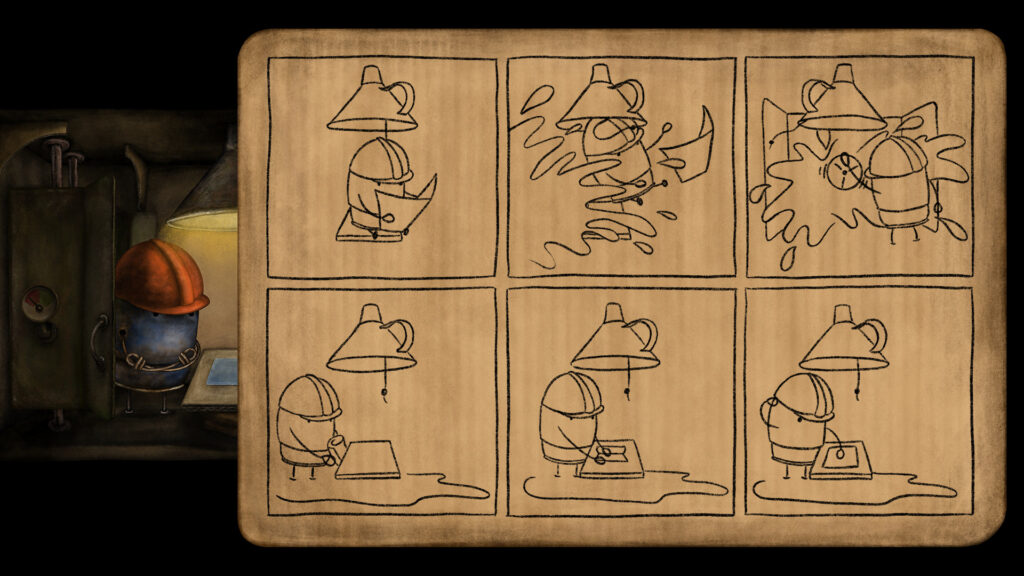
Another thing players might find narratively unsettling is the introduction of a new character in the closing cutscene. Generally, introducing something new once the plot has been resolved can feel jarring and this was definitely the case with Boxville. It’s a heart-warming moment but it felt out-of-place and a weird decision to include it at all. It certainly would have been better as a post-credits teaser, potentially teasing a well-deserving sequel.
Gameplay
Boxville is easy to play, mostly due to the limitations of the Puzzle Adventure genre. All you are required to do is pick up items (occasionally combining them to create new ones) and interact with your environment to solve puzzles. It’s so simple and approachable, it makes Boxville accessible on any device you choose to play it on. In this instance, moving the cursor around the screen didn’t feel sluggish and participating in puzzles felt intuitive and responsive (apart from a couple of puzzles towards the end).
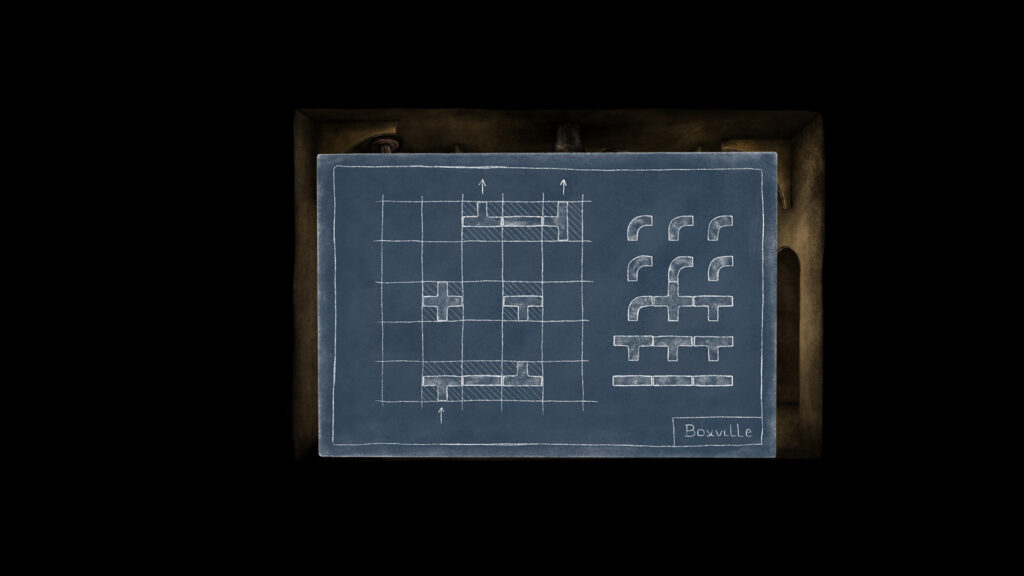
Moving Blue Can around the environment only requires a simple click in the spot you want to send him, and in circumstances where he can interact with the ground, two arrows appear to indicate that an action can be made. Besides that though, Boxville doesn’t highlight objects that can be interacted with so it is possible you will waste a lot of time frantically clicking on everything in the hopes that Blue Can will pick it up. It’s not necessary to expose puzzle elements with a glowing outline but it would certainly help if you struggle to contextualise some of the elements that can seamlessly blend into the background.
Level Design
Boxville has three main levels, each one broken up into various sections or rooms. For example, the first level Rooftop has two outdoor sections, a greenhouse, a stairway, a water maintenance room and a fishing spot. Before Blue Can can descend to the next level, he must fix everything that is broken, which eventually frees up an exit route. Most of the time, you will be navigating the world at a distance from a third-person perspective but most of the puzzles take on a first-person perspective, providing you with a more intimate approach. Rather than instructing Blue Can what to do, you instead become Blue Can and get to solve the puzzle for yourself.
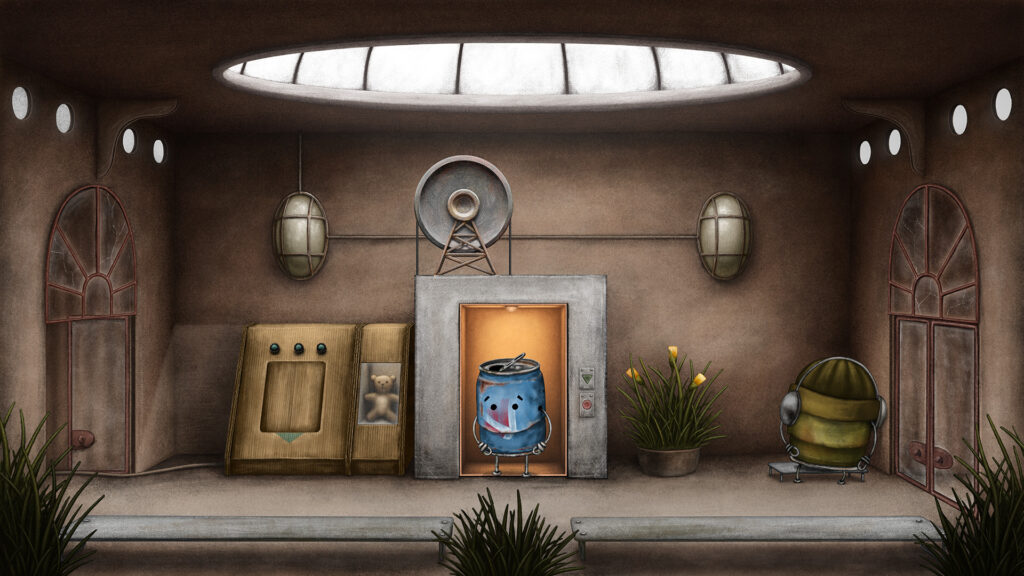
Each level pleasantly grows in size as well, which creates a fluid naturally-occurring difficulty curve. This provides you with more complex puzzles and different environments to see. However, as the levels grow, you are required to backtrack more often, and this can get frustrating during the experimental phase when you’re unsure of what to do. Although lovingly animated, watching Blue Can walk back and forth across sections (or watching unskippable animations of him riding an elevator) can become tiresome after a while.
Art Design
Boxville has an art style to be admired. It has this sketched-in-stone look, which adds to its industrial setting. Sometimes it even looks like faded stickers or sun-damaged cardboard, which is only fitting for a world made of paper. There are loads of fun little details, like how the sides of buildings have warning icons found on cardboard packaging, or how hinges are replaced with sticky tape for that truly recycled aesthetic. The areas that are made of stone have moss on them, implying Boxville is quite old and damp, perhaps indicating that this world might be located in a derelict place.
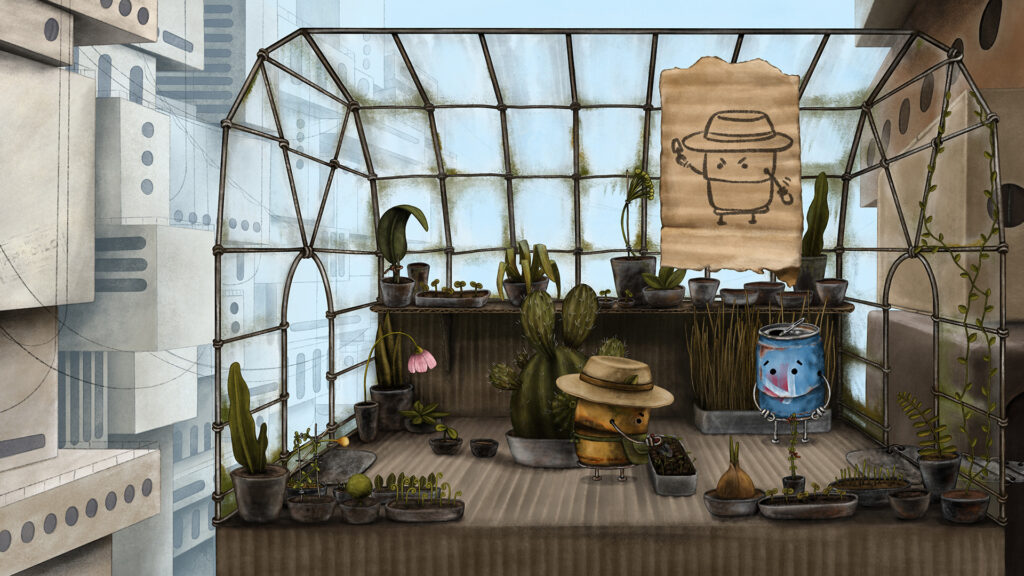
Boxville is also reminiscent of The Borrowers and Secret Life of Arrietty, where the small, mundane things take on a more vital and grandiose application for a miniature civilisation. It’s a fun idea and it’s one that developers Triomatica Games have successfully pulled off with their interpretation of what life must be like for a species of sentient trash.
It should not be ignored either, that Boxville has been painstakingly animated, which only adds to its charm.
Sound Design
The soundtrack of Boxville is super chill, creating a tranquil environment you can solve puzzles in stress-free. The music is intentionally relaxing, so there’s no need to worry about the distraction of an anxiety-inducing banger on your heels. Boxville doesn’t have a particularly varied soundtrack but it does a good enough job keeping the different levels effortlessly connected.
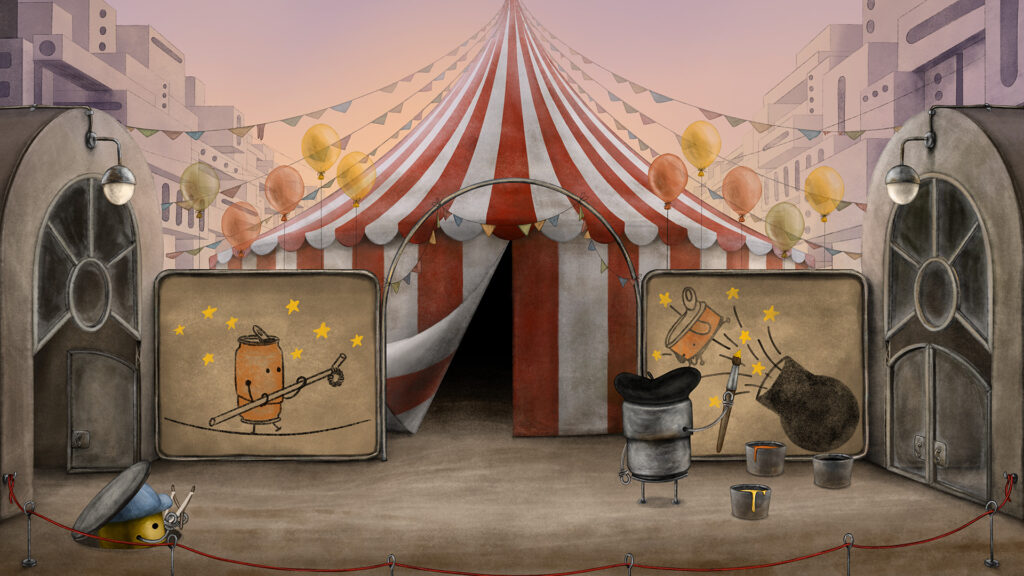
The sound you will hear the most is Blue Can as he clip-clops across Boxville. Some will definitely find it grating after a while but others will find it easy to ignore. A couple of clever sound effects are used to ground the experience and sell the premise that these tin items are genuinely alive; the unintelligible grunts of NPCs are tinny, and when Rusty barks it reverberates like the sound of a dog barking in a tunnel does. There are other lovely little details too, like the scratchy sound of metal-on-metal when certain NPCs move.
The Boxville OST is available to buy on Steam, so if you’re in need of a relaxing instrumental playlist you should consider purchasing it.
The Cons
It feels brutally harsh to say it, but Boxville is too short. It will only take you a couple of hours to finish, and once you know what to do you can quickly rattle through the three levels within an hour. It feels like an unfair criticism because of how much work has been spent on animating it but it should be considered a compliment – Boxville is such a fun and creative game, you will be craving to see more environments made of cardboard and more characters made of recyclable materials!
Another oversight is how the items you collect aren’t named. This would be extremely helpful, especially if you have forgotten what the item is supposed to be. For example, the suction cups (seen in the trailer) look like drum cymbals or glass lenses in the inventory, so using them to climb a wall might not necessarily be what you would try if you think they are something else. Annoyances like this can be avoided by naming the items in the inventory.
Conclusion
Should you play it? Yes
Why… Boxville might be short but it’s an enjoyable experience with some interesting puzzles. The concept of a small ecosystem of sentient garbage is a fun idea with lots to explore. Boxville scratches the surface and will leave you craving for more.
But… There’s really not much to pick fault at besides the short playtime. For that reason, it might be best played on mobile during a commute as it’s not a cinematic experience that benefits from being played on a big screen.
Final Score: 7/10
Reviewed on Xbox Series S
Developer: Triomatica Games
Publisher: Triomatica Games
Playable on: Xbox Series X/S, Xbox One, PlayStation 5, Steam, PC, Mobile
Released: 16th August 2023




